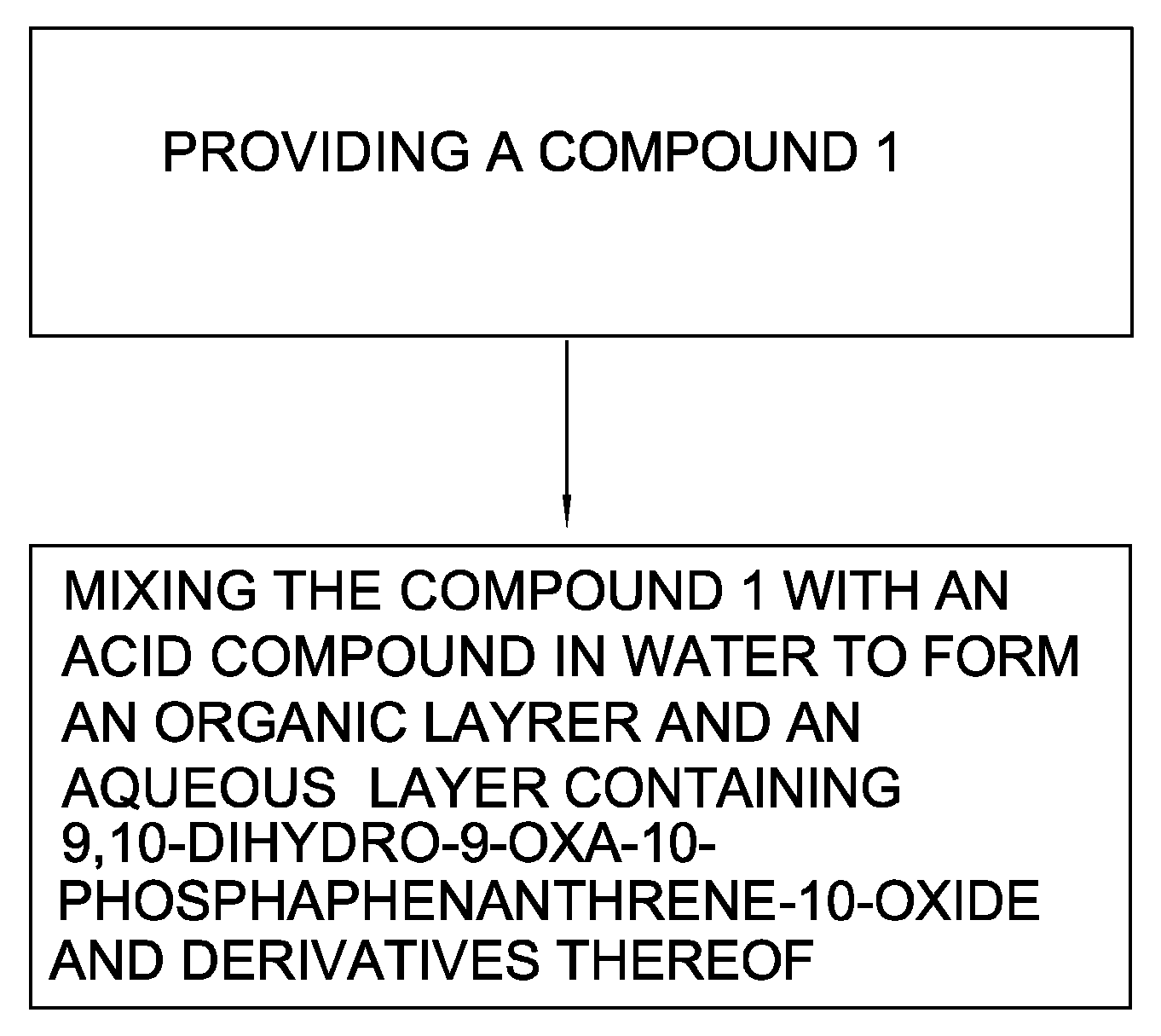Method for synthesizing 9,10-dihydro-9-oxa-10-phosphaphenanthrene-10-oxide and derivatives thereof
- Summary
- Abstract
- Description
- Claims
- Application Information
AI Technical Summary
Benefits of technology
Problems solved by technology
Method used
Image
Examples
example 1
Reaction without Acid Compound
[0056]10 g of 6-chloro-6H-dibenz[c,e][1,2]oxaphosphorin (0.0426 moles) and 20 g of deionized water were introduced into a reacting chamber and stirred for 5 minutes to form a solution. The solution was heated to 100° C. for 4 hours and 20 ml toluene added and then the solution was cooled to 30° C. to separate out a solid. The solution was filtered through a filter paper to obtain the solid. The solid was added to 20 ml ethanol for recrystallization to obtain a white crystalline powder. The crystalline powder was filtrated and subjected to a reduced pressure distillation at 160° C. under 0.3 mbar to obtain 6.91 g of white solid of 9,10-dihydro-9-oxa-10-phosphaphenanthrene-10-oxide [yield: 75%, color: 30 Hazen, purity: 95.35% (yield formula 2:formula 3=95.35%: 4.35%), melting point: 115.76° C. (temp. of DSC)].
example 2
Reaction with Hydrochloric Acid
[0057]10 g of 6-chloro-6H-dibenz[c,e][1,2]oxaphosphorin (0.0426 moles), 1.2 g hydrochloric acid (0.0335 moles) and 2.1 g of water were introduced into a reacting chamber and stirred for 5 minutes to form a solution. The solution was heated at 80° C. for 1 hour to obtain an organic layer and an aqueous layer. The organic layer was maintained at 80° C., separated from aqueous layer, put into another reacting chamber and subjected to a reduced pressure distillation at 165° C. under 0.3 mbar to obtain 9.03 g of white solid of 9,10-dihydro-9-oxa-10-phosphaphenanthrene-10-oxide (as shown in FIGS. 2 to 4) [yield: 98%, color: 8 Hazen, purity: 99.25% (formula 2:formula 3=99.25%:0.75%), melting point: 122.13° C. (DSC peak)](as shown in FIG. 5).
example 3
Reaction with Sulfuric Acid
[0058]10 g of 6-chloro-6H-dibenz[c,e][1,2]oxaphosphorin (0.0426 moles), 3.286 g sulfuric acid (0.0335 moles) and 3 g of water were introduced into a reacting chamber and stirred for 5 minutes to form a solution. The solution was heated at 80° C. for 5 hours to obtain an organic layer and an aqueous layer. The organic layer was maintained-at 80° C., separated from aqueous layer, put into another reacting chamber and subject to a reduced pressure distillation at 165° C. under 0.3 mbar to obtain 8.94 g of white solid of 9,10-dihydro-9-oxa-10-phosphaphenanthrene-10-oxide [yield: 97%, color: 10 Hazen, purity: 96.03% (formula 2:formula 3=96.03%:2.6%), melting point: 118.61° C. (DSC peak)].
PUM
 Login to View More
Login to View More Abstract
Description
Claims
Application Information
 Login to View More
Login to View More - R&D
- Intellectual Property
- Life Sciences
- Materials
- Tech Scout
- Unparalleled Data Quality
- Higher Quality Content
- 60% Fewer Hallucinations
Browse by: Latest US Patents, China's latest patents, Technical Efficacy Thesaurus, Application Domain, Technology Topic, Popular Technical Reports.
© 2025 PatSnap. All rights reserved.Legal|Privacy policy|Modern Slavery Act Transparency Statement|Sitemap|About US| Contact US: help@patsnap.com



